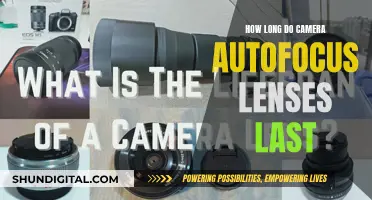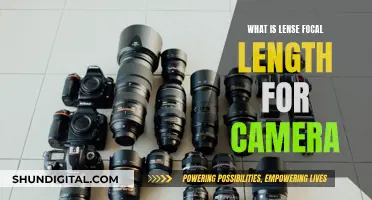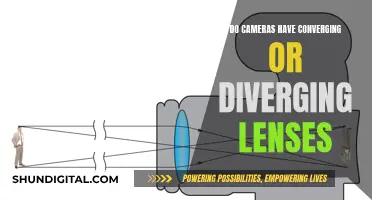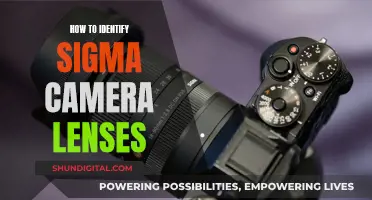
Camera lenses are an essential component of photography, working similarly to the human eye to control the amount of light entering the camera. They are optical lenses or assemblies of lenses that work with the camera body to capture images on film or other media. The lens is what allows photographers to focus light from the viewfinder into a tiny spot on the back of the camera, producing an image. Without a lens, a camera is useless, and the quality of the lens significantly impacts the resulting image. Interchangeable lenses are available for advanced photographers, with different types of lenses suited to various photography projects.
What You'll Learn

Camera lenses are made up of a series of convex and concave optical elements
Camera lenses are an essential component of photography, working in conjunction with the camera body to capture images. They are made up of a series of convex and concave optical elements that work together to bend light and refract it into a single sharp focal point. This process allows photographers to control the amount of light entering the camera, similar to how the human eye functions.
The design and construction of camera lenses vary, with some lenses permanently fixed to the camera and others interchangeable with different focal lengths, apertures, and properties. While a simple convex lens can be used, compound lenses made up of multiple optical elements are often required to correct optical aberrations. These aberrations can include issues such as blurriness and reduced light capture, which are minimised by the combination of convex and concave elements.
The front element of a camera lens is critical to its performance. It is usually coated to reduce abrasion, flare, and surface reflectance, as well as to adjust the colour balance. The curvature of this element is set to minimise aberration, and in prime lenses, this is easily achieved, while zoom lenses require a compromise.
Lenses with more optical elements can provide improved image quality by reducing aberrations. However, they may also transmit less light than lenses with fewer elements, assuming other factors such as aperture and focal length are equal. The number of elements in a lens can range from one, as in the Box Brownie's meniscus lens, to over 20 in complex zooms.
In summary, camera lenses are made up of a series of convex and concave optical elements that work together to capture and focus light, ultimately producing sharp and clear images. The combination of these elements allows photographers to capture a wide range of scenes and subjects, from landscapes to wildlife, with precision and creativity.
The Future of Photography: Cameras in Contact Lenses
You may want to see also

Focal length determines the magnification of the image
Camera lenses are optical lenses or assemblies of lenses used in conjunction with a camera body to capture images of objects. The lens is what focuses light from what you see through the viewfinder into a tiny, typically 35mm spot on the back of your film, DSLR, or mirrorless camera. The lens is what makes the difference between a white light image and a high-quality image.
The focal length of a lens is the distance from the surface of a lens to the focal point. The focal point is where light rays meet, and it is located on the principal axis of the lens. The focal length determines the magnification of the image projected onto the image plane. The longer the focal length, the higher the magnification, and vice versa. For example, a lens with a focal length of 200mm will offer more magnification than a lens with a focal length of 24mm.
The focal length of a lens is usually displayed on the lens itself and is measured in millimeters (mm). Lenses with different focal lengths can be used for different types of photography. Lenses with larger focal lengths, known as telephoto lenses, are often used for wildlife and sports photography, as they allow the photographer to zoom in on distant subjects. On the other hand, wide-angle lenses have smaller focal lengths and can capture a wider perspective, making them suitable for landscape photography or shooting in tight spaces.
The focal length of a lens also affects the perspective of the image. Photographs taken with different focal length lenses from the same distance will have different perspectives, even if the image size remains the same. For example, using a wide-angle lens to photograph a person stretching out their hand will make the hand look exaggeratedly large relative to the head. As the focal length increases, the emphasis on the outstretched hand decreases.
Additionally, the focal length of a lens determines the angle of view. Short focal lengths provide a wider field of view, while longer focal length lenses have a narrower angle of view. This is why wide-angle lenses are commonly used for landscape photography, while telephoto lenses are recommended for portraiture, as the longer focal length provides a more flattering perspective.
Tomorrow's Eclipse: Camera Lenses at Risk?
You may want to see also

Prime lenses have a single focal length
A prime lens is a fixed focal length lens, meaning it has a single, unchangeable angle of view. Prime lenses are the opposite of zoom lenses, which offer a range of focal lengths. Prime lenses are typically lighter, have a wider maximum aperture, and deliver superior image quality due to their fewer moving parts and simpler design.
Prime lenses are often preferred by photographers who want to improve their understanding of framing and composition. With a prime lens, you are forced to "zoom with your legs", moving closer or further from your subject to adjust your composition. This can lead to more creative and thoughtful photography.
Prime lenses also have wider apertures, such as f/1.8 or f/1.2, which allow for a shallow depth of field. This makes them ideal for portraits, product photography, or any situation where a soft, blurry background is desired. The wide aperture also lets in more light, making prime lenses suitable for low-light conditions.
In addition, prime lenses are typically sharper than zoom lenses, as their optical formula is optimised for a single focal length. They are also generally less expensive than zoom lenses of similar performance.
However, the fixed focal length of prime lenses can be limiting, as you cannot easily change your field of view without moving your position. This can be inconvenient, especially in fast-moving or hazardous situations. To cover a similar range of focal lengths as a zoom lens, you would need multiple prime lenses, which can be cumbersome to carry and switch between.
Overall, prime lenses offer a range of benefits, including superior image quality, wider apertures, and improved low-light performance. They are a great choice for photographers who want to improve their composition skills and get more creative with their photography.
Cleaning Camera Lenses: Removing Fungus and Mold
You may want to see also

Zoom lenses have variable focal lengths
Zoom lenses are a type of camera lens that offers photographers a range of focal lengths, making them highly versatile. They are often described by the ratio of their longest to shortest focal lengths. For example, a zoom lens with focal lengths ranging from 100mm to 400mm would be described as a 4:1 or "4x" zoom lens. This variable focal length allows photographers to modify the framing of their subject without having to physically move closer or farther away.
The convenience of zoom lenses comes at the cost of increased complexity and some compromises on image quality, weight, dimensions, aperture, autofocus performance, and cost. For instance, all zoom lenses suffer from at least a slight loss of image resolution at their maximum aperture, especially at the extremes of their focal length range. This effect is most noticeable in the corners of the image when displayed in a large format or high resolution. The greater the range of focal length offered by a zoom lens, the more these compromises are emphasised.
Zoom lenses are commonly used in still photography, cinematography, and with video cameras, projectors, binoculars, microscopes, telescopes, and other optical instruments. They are ideal when photographing a variety of subjects, such as landscapes and portraits, as they eliminate the need to constantly change lenses, saving time and reducing the risk of dust entering the camera.
Zoom lenses are distinguished from prime lenses, which have a fixed focal length. Prime lenses tend to be more compact and lightweight, with larger maximum apertures, making them well-suited for shooting in low-light conditions and achieving a shallow depth of field.
Welding and Cameras: Can Welding Damage Camera Lenses?
You may want to see also

Wide-angle lenses are good for landscape photography
A camera lens is an optical lens or assembly of lenses that work with a camera body to capture images on film or other media. Lenses can be permanently fixed to a camera or interchangeable.
Wide-angle lenses are a popular choice for landscape photography as they allow photographers to capture sweeping vistas and dramatic skies. They are also useful for shooting in tight spaces, such as interiors, and for emphasising foreground interest.
The main characteristics of wide-angle lenses are their extensive field of view, distinctive look, and large depth of field. They typically have a focal length of 35mm or less and a field of view greater than 65º. This allows photographers to get very close to their subject, creating a sense of drama and exaggerated perspective. The distance between the subject and background appears to increase, with the subject looming large in the frame while everything else stretches out behind it.
Wide-angle lenses also offer a unique distortion effect, particularly in the corners and edges of the frame, which can help to pull viewers into the composition. This type of lens inherently has a large depth of field, allowing photographers to keep everything in focus from the foreground to the horizon.
When using a wide-angle lens for landscape photography, it is important to consider the foreground interest and how it relates to the background. Shapes are important; diagonal lines and triangles draw the viewer in, while squares and rectangles can block the view. Getting low can emphasise the foreground but may reduce the perception of depth. Experimenting with different heights can help find the best balance.
Additionally, the distortion of wide-angle lenses can be used to exaggerate natural lines and angles, especially when shooting architectural subjects. Pointing the lens upwards can create eye-catching compositions with dynamic angles.
While wide-angle lenses are excellent for capturing big views and creating dramatic perspectives, they also present some challenges. Framing can be tricky, especially with ultra-wide lenses, as it can be difficult to find a coherent composition that is not too busy. It is important to look for strong foregrounds and dynamic lines to add structure to the image.
Distortion is another issue, particularly with buildings, as they can appear to lean at odd angles. Keeping the camera level can help reduce this effect, although perspective corrections can also be made in post-production if needed.
In summary, wide-angle lenses are a popular choice for landscape photography due to their ability to capture expansive scenes, create dramatic perspectives, and offer unique visual effects. They provide a versatile and creative tool for photographers looking to showcase sweeping vistas and emphasise the relationship between foreground and background elements.
Renting Camera Lenses: A Guide to Getting Started
You may want to see also
Frequently asked questions
A camera lens is an optical lens or assembly of lenses that work with a camera body to capture images on film or other media.
There are two main types of camera lenses: zoom lenses and prime lenses. Zoom lenses have variable focal lengths, allowing you to zoom in and out. Prime lenses have a fixed focal length, so you can't zoom in or out.
Zoom lenses are versatile and can be used for a wide range of photography, from street photography to wildlife photography.
Prime lenses are specialised and deliver higher-quality images for a specific type of photography. For example, a 50mm prime lens is perfect for portraits, while a 35mm prime lens is often used for landscapes.
The right lens depends on your photography needs. Consider the focal length, whether you want a prime or zoom lens, the shutter speed, aperture, and compatibility with your camera.







